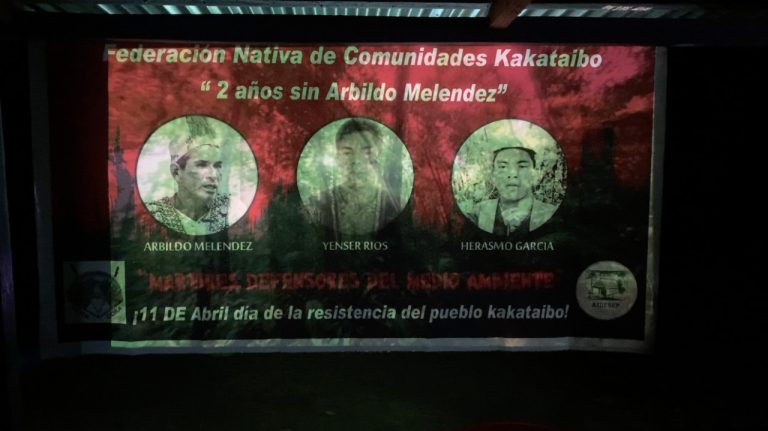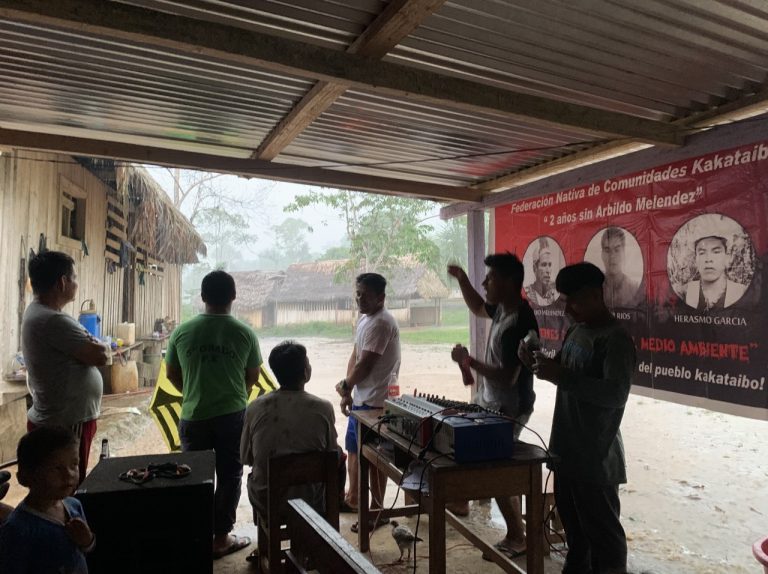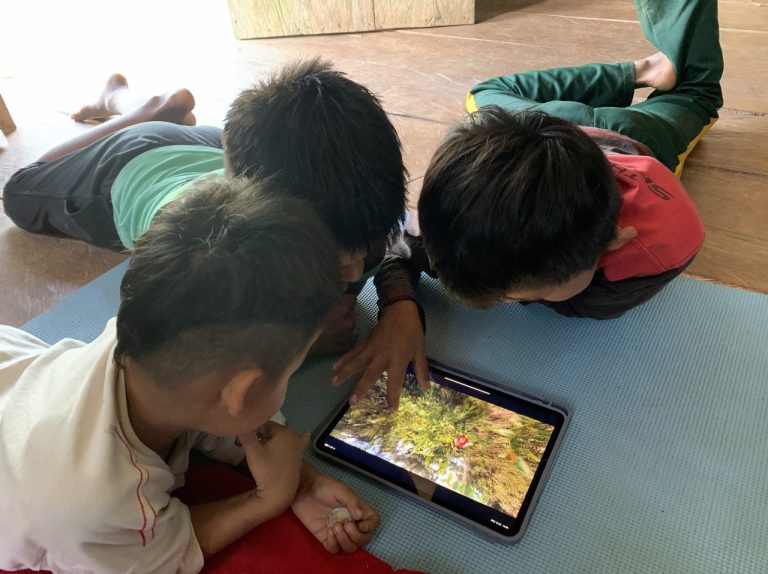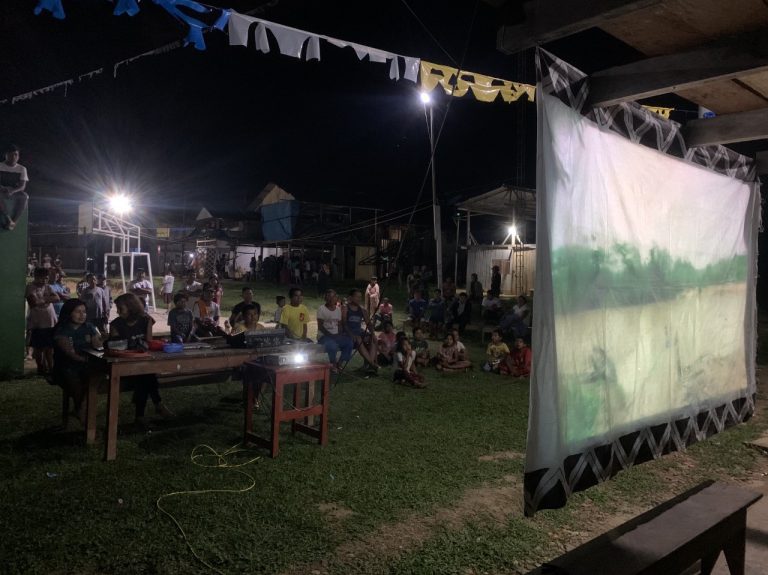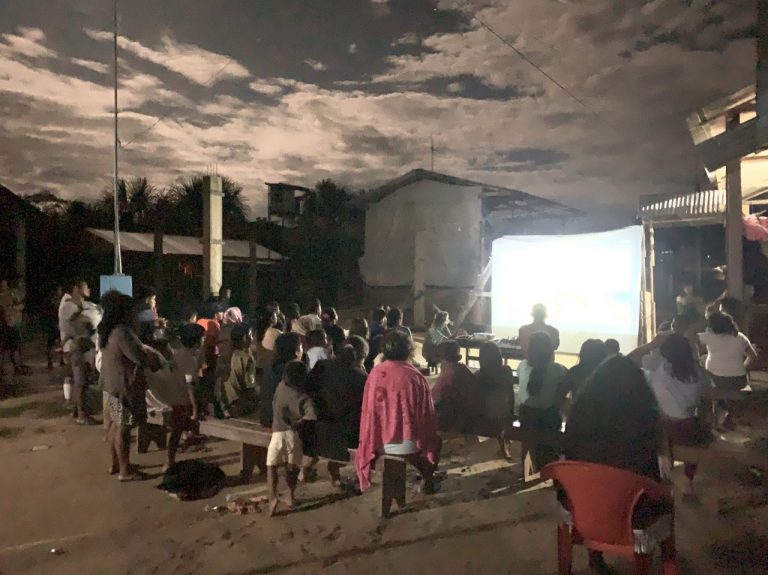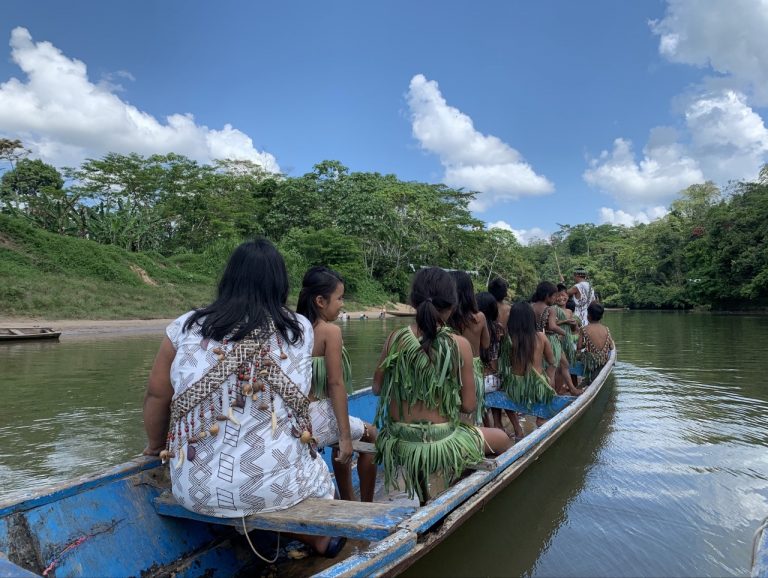SCREENINGS AND REFLECTIONS ON THREATENED TERRITORIES
In conversation with artist Eliana Otta, we spoke about her trip to the area of Pucallpa in Peru. There, she revisited the communities Unipacuyacu, Sinchi Rocha and Puerto Nuevo, screening the work in progress of Virtual Sanctuary of Fertilizing Mourning in order to integrate the communities’ feedback into the project.
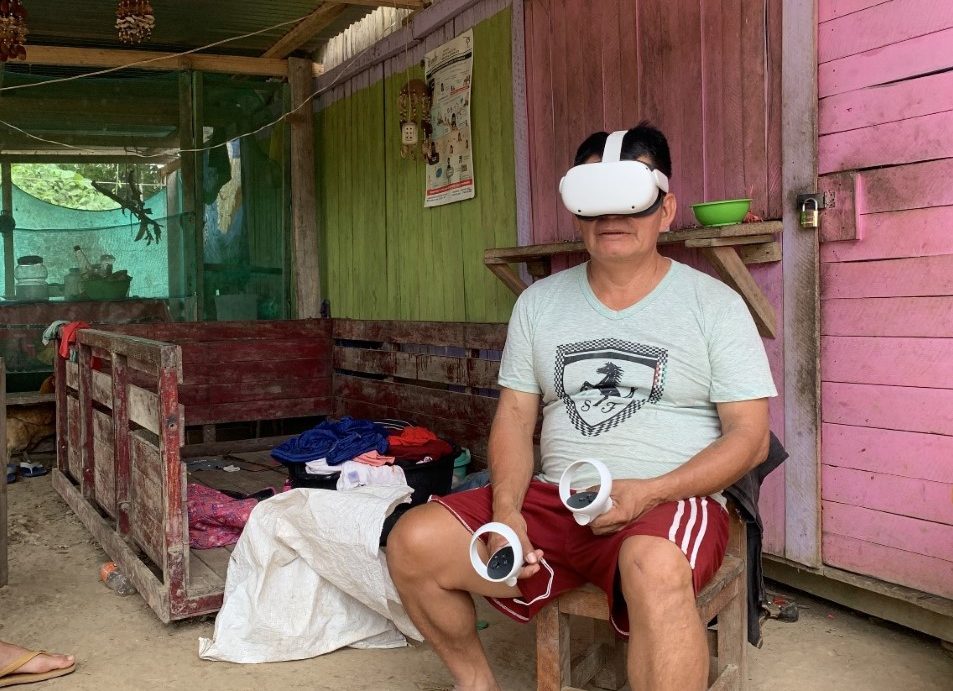
Unipacuyacu’s leader, Marcelino Tangoa, trying up the VR version of the project.
“A special moment happened at Unipacuyacu, the first night we tried to screen the videos. I asked Marcelino, the leader, if he had a bedsheet or any surface to project on. He came back holding a banner that they printed on the two year anniversary of the killing of Arbildo Melendez’s, the former leader, asking if it could work to project on the back of it. Not only it was a great surface to project on, but it also created a moving, phantasmagoric experience, to watch the videos of the territory he was defending, screened on his face and the face of Yener Ríos and Herasmo García, the environmental defenders assassinated in Puerto Nuevo. Another layer was added in that way, spontaneously, to the evening, while literally shedding light on those lives lost to the actions of wood fellers and drug traffickers.”
These words by artist Eliana Otta introduce not only into one of her experiences screening her work for the Unipacuyacu community in Peru, but also into the complex layers of the screened work itself. In February 2022, Eliana Otta and the filmmaker Nuno Cassola went on a research trip to Peru visiting the four communities Unipacuyacu, Sinchi Rocha, Puerto Nuevo, and Nuevo Amanecer Hawai to learn about their assassinated leaders and their threatened territories. During their stay, Otta and Cassola recorded visual footage of the daily lives of the communities within their territories, their stories and cultural objects. Based on this footage, Otta is building a virtual space for mourning for the communities that can also serve as a communication tool to bring these issues to the attention of a wider public. Over the summer of 2022, Otta and Cassola returned to Peru to revisit the four communities, show them the work in progress and include the feedback in the making of the work. They ended up visiting three of the four communities, as Nuevo Amanecer Hawai was busy building an essential road to their community, which had to be finished before the start of the rainy season. The aim of these screenings was not only to get feedback, but also for them to consent to their voices and images being used, and to make sure the visual material matched their perception of the situation. The screenings took place under very diverse conditions, depending on each communities’ access to electricity and technology. With electric generators Otta and Cassola were able to screen the works onto unconventional and surprising surfaces such as the above-mentioned banner. In the following, Otta describes her screening experience with the Unipacuyacu community:
“We went there with a projector we rented in Pucallpa to people who teach cinematographic tools to indigenous students, but we couldn’t bring much equipment because of the weight, because getting there involves taking cars, mototaxis and boats, so we needed to travel as light as possible. That night we didn’t manage to properly connect the sound, since our cables were not compatible with their mixer. The next day, they brought a huge, professional mixer with a boat from a nearby town. After making the shoot with them wearing their traditional tunics (cushmas), we gathered again around the projector and connected everything. When we were ready to start, rain started pouring intensely and we all had to go undercover, bringing the equipment under the roof. Children, young and old people, we all had to go undercover in a space of 30 square meters, also protected by the banner with Arbildo’s face printed which would be used as a screen. Once there, the young guys in charge of the mixer connected it, and we spent an hour together in our makeshift refuge, listening and even dancing to a bit of cumbia and techno from the 90’s. The young men passed a bottle of a drink from hand to hand, sharing it with us, while the women took care of the babies and Camilo, an eight-year-old kid, played in the soccer field in front of us. Alone, totally wet, he ran everywhere under the rain. I asked him to wear the 360 degree camera on his head for a while, and he left with it happily, while we all stayed under the shelter hearing ‘this is the rhythm of the night.’”
After the screenings, Otta discussed the community’s responses to the work, their thoughts on representation and what could be missing.
“Probably the most notable thing was that the three [communities] expressed their desire to have videos appearing with their traditional clothes. Since the videos were made trying to avoid disrupting their normal lives, in all of them they appeared wearing their everyday clothes, the same as any person would wear in an urban context. Now that they saw themselves on the big screen, they felt that their indigeneity was missing and feared that they would be confused with any ‘mestizo’ (mixed race person). This was expressed with different words in each place, but the content of the message was the same: they wanted us to make more videos with them wearing their traditional dresses, also explicitly making traditional activities such as fishing with arrows or making handcrafts. In some places they talked about the pride of showing such things and the relevance of showing the grandparent’s ways of doing things. In another place someone also mentioned that if they didn’t seem indigenous then people would not help us. It was never an innocent request, but one connected to their present struggles and demands, in which the indigenous identity is densely tied to the cultural traditions and the land they inhabit.”
After the screenings, Otta and Cassola shot more footage with the communities. In the upcoming weeks they will finish the editing and color correction, while the animation studio Hermanos Magia, a Peruvian interdisciplinary team, is creating the virtual platform that will host the videos beyond the exhibition period. The project will be translated into English, and from the languages Cacataibo and Ashninka to Spanish. In a final installation format, the project will include the videos, as well as sound pieces and drawings by Eliana Otta. The final presentation of the Virtual Sanctuary of Fertilizing Mourning will take place at the upcoming Driving the Human festival at the silent green in Berlin, a venue that was formerly home to a crematorium – also a place for mourning.
Images by Eliana Otta, Text by Aisha Altenhofen

